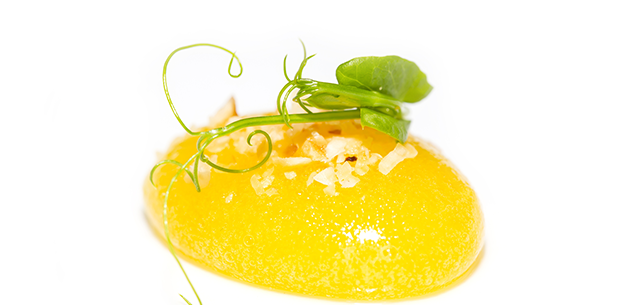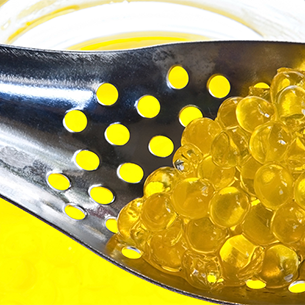.png.transform/rendition-xs/image_image%20(1).png)
Spherification
Hearing the word "chemistry" used in a culinary context might shock some people. This is probably because they immediately associate the term with the use of chemical products, something that sounds noxious or damaging to health.
However, the truth is that using certain chemical products in cooking brings nothing more threatening than innovation, or, put differently, a little touch of magic that takes advantage of changes in the composition and texture of some foods when different elements are mixed together.
This is how the spherification technique created by Ferran Adrià and his elBulli team in 2003 works. It is based on the reaction produced when elements used in the food industry, such as sodium alginate (Algin, a product derived from a natural seaweed extract) and calcium chloride (Calcic, a highly water soluble salt used by the food industry for making some cheeses) are combined to make new foods in the form of spheres.
What is involved?
The method uses the gelling properties of alginate in the presence of calcium. The aim is to get a small quantity of liquid previously mixed with Algin to become wrapped in a membrane when submerged in a solution of water and Calcic, making spheres that preserve the original flavor on the palate.
If the liquid to be spherified is very acidic, such as grapefruit, lemon or orange juice for example, sodium citrate is used (Citras, a product obtained mainly from citrus fruits) to reduce the pH value and enable the reaction to be effective. This process is known as basic or direct spherification, although it can be done in reverse, by adding calcium chloride to the product being spherified and immersing it in a solution of water with sodium alginate.
This is known as indirect spherification and is used when the product being spherified naturally contains calcium chloride, milk or yogurt for example, that reacts with the sodium alginate and produces an immediate gelling effect.
What does spherification achieve?
This technique produces spheres of different sizes, textures and consistencies. Depending on the immersion time, it is possible to control the thickness of the walls of the spheres so that they give the sensation of "exploding" on the palate. It is also possible to manipulate the spheres produced, for example by introducing solid elements in suspension inside the liquid.
The various shapes vary from raviolis, marbles, caviar, shot, pearls, balloons and even spherical noodles. The difference in size is achieved by controlling the dose of the liquid to be spherified. The evolution of this technique combined with the siphon has allowed a further step to be taken of making spherified foam, providing a new texture that is completely different from conventional spherification.
What do you need to do spherification?
For spherification you do not need to have any specific utensils or sophisticated material. There are even starter kits on the market for people to practice in their own kitchen at home. Apart from the essential additives, Algin and Calcic, you only need spherical spoons and different sized syringes, a recipient or tray and draining spoons.
The results?
Out of the huge variety of dishes made using this technique, some of the most outstanding are spherified olives, liquid croquettes and melon caviar.
Paco Roncero is head chef of La Terraza del Casino restaurant (Madrid)


- Spherification 1
- Spherification 2
